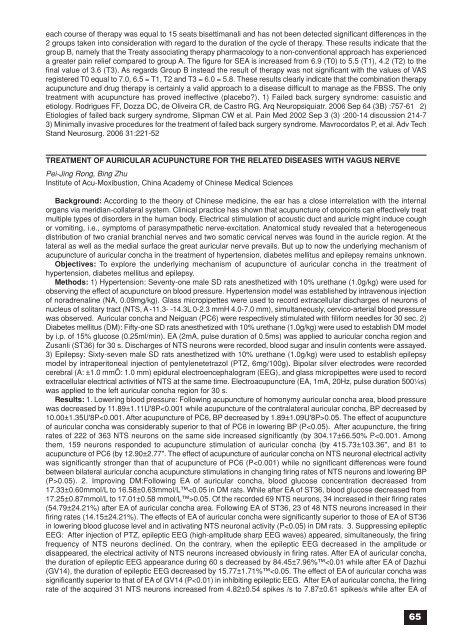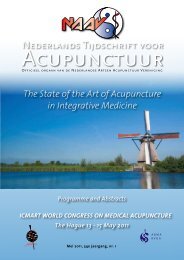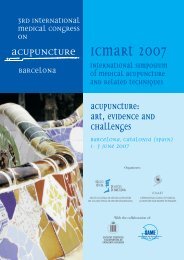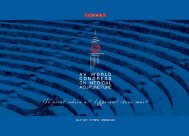Congress Abstracts full PDF - International Council of Medical ...
Congress Abstracts full PDF - International Council of Medical ...
Congress Abstracts full PDF - International Council of Medical ...
Create successful ePaper yourself
Turn your PDF publications into a flip-book with our unique Google optimized e-Paper software.
each course <strong>of</strong> therapy was equal to 15 seats bisettimanali and has not been detected significant differences in the<br />
2 groups taken into consideration with regard to the duration <strong>of</strong> the cycle <strong>of</strong> therapy. These results indicate that the<br />
group B, namely that the Treaty associating therapy pharmacology to a non-conventional approach has experienced<br />
a greater pain relief compared to group A. The figure for SEA is increased from 6.9 (T0) to 5.5 (T1), 4.2 (T2) to the<br />
final value <strong>of</strong> 3.6 (T3). As regards Group B instead the result <strong>of</strong> therapy was not significant with the values <strong>of</strong> VAS<br />
registered T0 equal to 7.0, 6.5 = T1, T2 and T3 = 6.0 = 5.8. These results clearly indicate that the combination therapy<br />
acupuncture and drug therapy is certainly a valid approach to a disease difficult to manage as the FBSS. The only<br />
treatment with acupuncture has proved ineffective (placebo). 1) Failed back surgery syndrome: casuistic and<br />
etiology. Rodrigues FF, Dozza DC, de Oliveira CR, de Castro RG. Arq Neuropsiquiatr. 2006 Sep 64 (3B) :757-61 2)<br />
Etiologies <strong>of</strong> failed back surgery syndrome, Slipman CW et al. Pain Med 2002 Sep 3 (3) :200-14 discussion 214-7<br />
3) Minimally invasive procedures for the treatment <strong>of</strong> failed back surgery syndrome. Mavrocordatos P, et al. Adv Tech<br />
Stand Neurosurg. 2006 31:221-52<br />
TREATMENT OF AURICULAR ACUPUNCTURE FOR THE RELATED DISEASES WITH VAGUS NERVE<br />
Pei-Jing Rong, Bing Zhu<br />
Institute <strong>of</strong> Acu-Moxibustion, China Academy <strong>of</strong> Chinese <strong>Medical</strong> Sciences<br />
Background: According to the theory <strong>of</strong> Chinese medicine, the ear has a close interrelation with the internal<br />
organs via meridian-collateral system. Clinical practice has shown that acupuncture <strong>of</strong> otopoints can effectively treat<br />
multiple types <strong>of</strong> disorders in the human body. Electrical stimulation <strong>of</strong> acoustic duct and auricle might induce cough<br />
or vomiting, i.e., symptoms <strong>of</strong> parasympathetic nerve-excitation. Anatomical study revealed that a heterogeneous<br />
distribution <strong>of</strong> two cranial branchial nerves and two somatic cervical nerves was found in the auricle region. At the<br />
lateral as well as the medial surface the great auricular nerve prevails. But up to now the underlying mechanism <strong>of</strong><br />
acupuncture <strong>of</strong> auricular concha in the treatment <strong>of</strong> hypertension, diabetes mellitus and epilepsy remains unknown.<br />
Objectives: To explore the underlying mechanism <strong>of</strong> acupuncture <strong>of</strong> auricular concha in the treatment <strong>of</strong><br />
hypertension, diabetes mellitus and epilepsy.<br />
Methods: 1) Hypertension: Seventy-one male SD rats anesthetized with 10% urethane (1.0g/kg) were used for<br />
observing the effect <strong>of</strong> acupuncture on blood pressure. Hypertension model was established by intravenous injection<br />
<strong>of</strong> noradrenaline (NA, 0.09mg/kg). Glass micropipettes were used to record extracellular discharges <strong>of</strong> neurons <strong>of</strong><br />
nucleus <strong>of</strong> solitary tract (NTS, A -11.3- -14.3L 0-2.3 mmH 4.0-7.0 mm), simultaneously, cervico-arterial blood pressure<br />
was observed. Auricular concha and Neiguan (PC6) were respectively stimulated with filiform needles for 30 sec. 2)<br />
Diabetes mellitus (DM): Fifty-one SD rats anesthetized with 10% urethane (1.0g/kg) were used to establish DM model<br />
by i.p. <strong>of</strong> 15% glucose (0.25ml/min). EA (2mA, pulse duration <strong>of</strong> 0.5ms) was applied to auricular concha region and<br />
Zusanli (ST36) for 30 s. Discharges <strong>of</strong> NTS neurons were recorded, blood sugar and insulin contents were assayed.<br />
3) Epilepsy: Sixty-seven male SD rats anesthetized with 10% urethane (1.0g/kg) were used to establish epilepsy<br />
model by intraperitoneal injection <strong>of</strong> pentylenetetrazol (PTZ, 6mg/100g). Bipolar silver electrodes were recorded<br />
cerebral (A: ±1.0 mmÕ: 1.0 mm) epidural electroencephalogram (EEG), and glass micropipettes were used to record<br />
extracellular electrical activities <strong>of</strong> NTS at the same time. Electroacupuncture (EA, 1mA, 20Hz, pulse duration 500¼s)<br />
was applied to the left auricular concha region for 30 s.<br />
Results: 1. Lowering blood pressure: Following acupuncture <strong>of</strong> homonymy auricular concha area, blood pressure<br />
was decreased by 11.89±1.11U'8P0.05. The effect <strong>of</strong> acupuncture<br />
<strong>of</strong> auricular concha was considerably superior to that <strong>of</strong> PC6 in lowering BP (P







